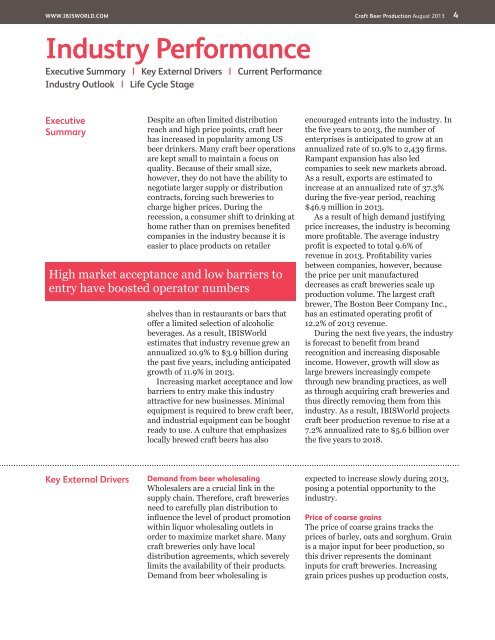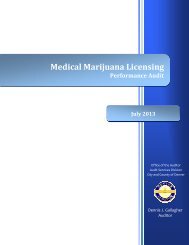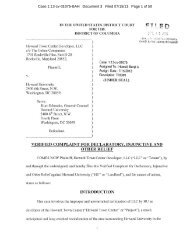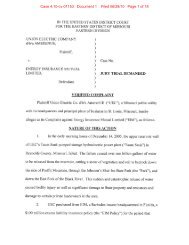Craft Beer Production - The Business Journals
Craft Beer Production - The Business Journals
Craft Beer Production - The Business Journals
You also want an ePaper? Increase the reach of your titles
YUMPU automatically turns print PDFs into web optimized ePapers that Google loves.
WWW.IBISWORLD.COM <strong>Craft</strong> <strong>Beer</strong> <strong>Production</strong>August 2013 4Industry PerformanceExecutive Summary | Key External Drivers | Current PerformanceIndustry Outlook | Life Cycle StageExecutiveSummaryDespite an often limited distributionreach and high price points, craft beerhas increased in popularity among USbeer drinkers. Many craft beer operationsare kept small to maintain a focus onquality. Because of their small size,however, they do not have the ability tonegotiate larger supply or distributioncontracts, forcing such breweries tocharge higher prices. During therecession, a consumer shift to drinking athome rather than on premises benefitedcompanies in the industry because it iseasier to place products on retailerHigh market acceptance and low barriers toentry have boosted operator numbersshelves than in restaurants or bars thatoffer a limited selection of alcoholicbeverages. As a result, IBISWorldestimates that industry revenue grew anannualized 10.9% to $3.9 billion duringthe past five years, including anticipatedgrowth of 11.9% in 2013.Increasing market acceptance and lowbarriers to entry make this industryattractive for new businesses. Minimalequipment is required to brew craft beer,and industrial equipment can be boughtready to use. A culture that emphasizeslocally brewed craft beers has alsoencouraged entrants into the industry. Inthe five years to 2013, the number ofenterprises is anticipated to grow at anannualized rate of 10.9% to 2,439 firms.Rampant expansion has also ledcompanies to seek new markets abroad.As a result, exports are estimated toincrease at an annualized rate of 37.3%during the five-year period, reaching$46.9 million in 2013.As a result of high demand justifyingprice increases, the industry is becomingmore profitable. <strong>The</strong> average industryprofit is expected to total 9.6% ofrevenue in 2013. Profitability variesbetween companies, however, becausethe price per unit manufactureddecreases as craft breweries scale upproduction volume. <strong>The</strong> largest craftbrewer, <strong>The</strong> Boston <strong>Beer</strong> Company Inc.,has an estimated operating profit of12.2% of 2013 revenue.During the next five years, the industryis forecast to benefit from brandrecognition and increasing disposableincome. However, growth will slow aslarge brewers increasingly competethrough new branding practices, as wellas through acquiring craft breweries andthus directly removing them from thisindustry. As a result, IBISWorld projectscraft beer production revenue to rise at a7.2% annualized rate to $5.6 billion overthe five years to 2018.Key External DriversDemand from beer wholesalingWholesalers are a crucial link in thesupply chain. <strong>The</strong>refore, craft breweriesneed to carefully plan distribution toinfluence the level of product promotionwithin liquor wholesaling outlets inorder to maximize market share. Manycraft breweries only have localdistribution agreements, which severelylimits the availability of their products.Demand from beer wholesaling isexpected to increase slowly during 2013,posing a potential opportunity to theindustry.Price of coarse grains<strong>The</strong> price of coarse grains tracks theprices of barley, oats and sorghum. Grainis a major input for beer production, sothis driver represents the dominantinputs for craft breweries. Increasinggrain prices pushes up production costs,
















